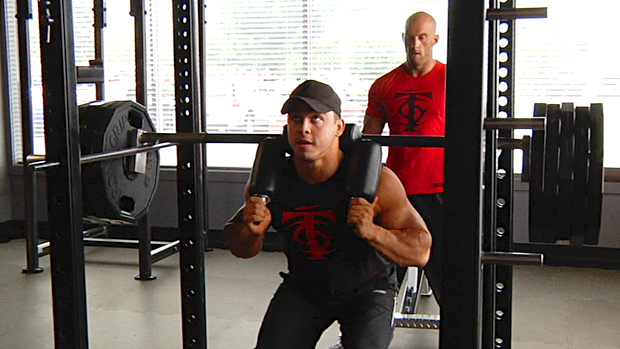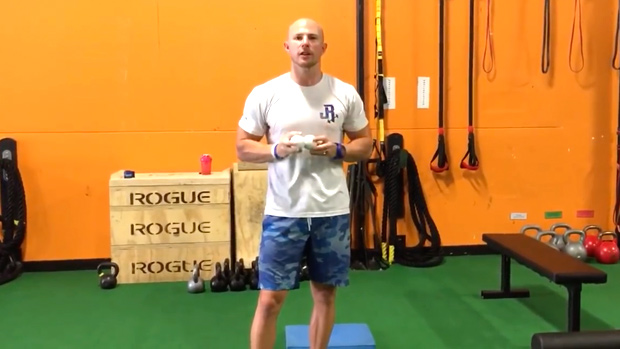The snatch-grip podium deadlift is one of the many gems Charles Poliquin introduced to the masses. It's a wide-grip deficit deadlift, which creates a massive range of movement. Basically, it's the deadlift variation that makes people puke.
When your goal is to beef up the entire posterior chain, this lift is in a league of its own. It quickly develops the upper back, strengthens the glutes and hamstrings, and hammers the spinal erectors.
It also carries over to the squat and standard deadlift. After a training cycle that includes snatch-grip deficit pulls, your back will feel a lot more stable under heavy loads on the main lower-body lifts, which sets you up for new personal bests.
Lifter beware: the snatch-grip podium deadlift leads to massive lower back pumps during your workout and often causes debilitating posterior chain DOMS over the next 24-72 hours.
With that out of the way, let's cover the main points:
- Start light. I mean, LIGHT. Load the bar with 50% of your 1RM (conventional or sumo, whichever is your go-to variation) to get the hang of the movement on your first set. Then go up from there.
- Stand on a platform or plates to increase range of motion. More on choosing the right height below.
- I have a short wingspan, so placing my index finger on the inside dual ring on an Olympic bar works best for me. Bigger guys can move out a bit, but don't go collar to collar – index finger somewhere around the outside ring should do the trick.
- Regardless of grip width, turn your elbows out. They should stay locked and in line with the barbell.
- As with regular deadlifts, get your breath in, engage the lats, and set your back.
- Maintaining a neutral back position and keeping the bar close to your body at all times, push your feet through the podium. Chest stays up, butt stays down. Finish by squeezing the glutes at the top.
- Reverse the movement and lower under control in 5 seconds. Stay tight and resist the weight all the way down.
- Use straps when needed. Your grip will give out well before your legs or back.
Poliquin recommended pulling from a 4-inch deficit for maximal results, but few people have the technique or mobility to do this safely on their first try. If that's you, then flip the setup on its head: stand on the floor and elevate the bar on plates or blocks. This is just your starting point.
Thanks to the shorter range of motion, it'll be easier to get into the right starting position and complete all reps with good form. So you reap the strength and muscle-building benefits without risking back injury.
Then as your mobility and control improve over time, dump the blocks and pull from the floor in a regular snatch-grip deadlift. Eventually, graduate to the podium version.
Once you do use a deficit, start with a small one like of 1 to 1.5 inches and work your way up to the 4-inch platform.
The hockey athletes I train use snatch-grip podium deadlifts in high-volume blocks to bring up lagging posterior chain muscles. We typically do 3-4 sets of 6-8 reps in the early off-season (general preparation phase). Then we'll do 3-5 sets of 5 reps later during the summer to lay the groundwork for a max strength phase. During both we use a 5-second eccentric.
Don't batter yourself with too much volume, especially if you're new to it. I, like many of my athletes, get almost unbearable lower back pumps just from three work sets of 5-8 reps. You don't need to trash yourself to see results.
The good news? Since your spinal erectors become more resilient after every iron beating they take, you'll be able to increase resistance for many weeks to come.
A solid goal to strive for is 80-5-5-4. It stands for:
- 80% of your deadlift (sumo or conventional) 5RM
- Done for 5 reps
- Using a 5-second lowering
- While standing on a 4-inch podium
So if your deadlift 5RM is 405 pounds, then aim for pulling 325 (80% of 405) for 5 reps with a 5-second eccentric from a 4-inch deficit. This is a sign your posterior chain strength is up to snuff.
If the ratio between eccentric-emphasized snatch-grip podium deadlifts and regular pulls falls well below 80%, you know your lower back limits the loads you can hoist on the latter. Erasing this gap will translate into major deadlift PRs down the line.



